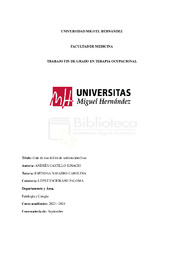Por favor, use este identificador para citar o enlazar este ítem:
https://hdl.handle.net/11000/35827Registro completo de metadatos
| Campo DC | Valor | Lengua/Idioma |
|---|---|---|
| dc.contributor.advisor | Espinosa Navarro, Carolina | - |
| dc.contributor.advisor | López Escribano, Paloma | - |
| dc.contributor.author | Andrés Catillo, Ignacio | - |
| dc.contributor.other | Departamentos de la UMH::Patología y Cirugía | es_ES |
| dc.date.accessioned | 2025-03-07T08:09:20Z | - |
| dc.date.available | 2025-03-07T08:09:20Z | - |
| dc.date.created | 2024-09-04 | - |
| dc.identifier.uri | https://hdl.handle.net/11000/35827 | - |
| dc.description.abstract | Los productos de apoyo (PA) están pensados y desarrollados para personas con discapacidad (PD), con el propósito de facilitar la participación, entrenar, medir, sustituir, proteger o apoyar funciones corporales y actividades, también con la intención de prevenir futuras limitaciones o deficiencias. Su uso pretende realizar las tareas de forma más segura, eficiente y cómoda, disminuyendo el esfuerzo y retrasando los procesos degenerativos o dolencias. Las sillas de ruedas (SR) son claros ejemplos de PA para las personas con discapacidad física. La correcta adaptación de estos PA es crucial para evitar consecuencias negativas, como mayor consumo energético, sobrecargas o lesiones. Las personas con parálisis cerebral (PC) requieren adaptaciones específicas tanto para mantener la postura como para facilitar su participación en las actividades de la vida diaria (AVD). La ergonomía en Terapia Ocupacional (TO) es fundamental para acondicionar y adecuar entornos y productos para mejorar la calidad de vida de las personas con discapacidad. Asesorar sobre qué PA es más adecuado, adaptarlo si es necesario y enseñarle a la persona como se utiliza, son funciones importantes dentro de la TO. La guía de uso del producto de apoyo Kit de sedestación Osso, está diseñada con el objetivo de maximizar los beneficios de la utilización del kit en personas con PC o afines que tienen dificultades en el control de tronco. Los objetivos específicos incluyen proporcionar información clara y gráfica sobre su uso, garantizar la seguridad del usuario, resolver dudas y prevenir deformidades o problemas asociados con un uso incorrecto del kit. | es_ES |
| dc.description.abstract | Assistive products (AP) are designed and developed for people with disabilities, with the purpose of facilitating participation, training, measuring, replacing, protecting or supporting bodily functions and activities, also with the intention of preventing future limitations or impairments. Its use aims to perform tasks in a safer, more efficient and comfortable way, reducing effort and delaying degenerative processes or ailments. Wheelchairs (SRs) are clear examples of PA for people with physical disabilities. The correct adaptation of these APs is crucial to avoid negative consequences, such as increased energy consumption, overloads or injuries. People with cerebral palsy (CP) require specific adaptations to both maintain posture and to facilitate their participation in activities of daily living (ADLs). Ergonomics in Occupational Therapy (OT) is essential to condition and adapt environments and products to improve the quality of life of people with disabilities. Advising on which PA is most suitable, adapting it if necessary, and teaching the person how to use it, are important functions within OT. The guide for use of the Osso Sitting Kit support product is designed with the aim of maximizing the benefits of using the kit in people with CP or similar people who have difficulties in trunk control. Specific objectives include providing clear and graphic information on its use, ensuring user safety, resolving questions and preventing deformities or problems associated with incorrect use of the kit. | es_ES |
| dc.format | application/pdf | es_ES |
| dc.format.extent | 56 | es_ES |
| dc.language.iso | spa | es_ES |
| dc.publisher | Universidad Miguel Hernández | es_ES |
| dc.rights | info:eu-repo/semantics/openAccess | es_ES |
| dc.rights.uri | http://creativecommons.org/licenses/by-nc-nd/4.0/ | * |
| dc.subject | terapia ocupacional | es_ES |
| dc.subject | productos de apoyo | es_ES |
| dc.subject | parálisis cerebral | es_ES |
| dc.subject | sillas de ruedas | es_ES |
| dc.subject | pobre control de tronco. | es_ES |
| dc.subject.other | CDU::6 - Ciencias aplicadas | es_ES |
| dc.title | Guía de uso del kit de sedestación Osso | es_ES |
| dc.type | info:eu-repo/semantics/bachelorThesis | es_ES |

Ver/Abrir:
TFG Ignacio Andrés Castillo (1).pdf
21,62 MB
Adobe PDF
Compartir:
 La licencia se describe como: Atribución-NonComercial-NoDerivada 4.0 Internacional.
La licencia se describe como: Atribución-NonComercial-NoDerivada 4.0 Internacional.
.png)